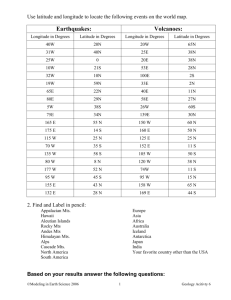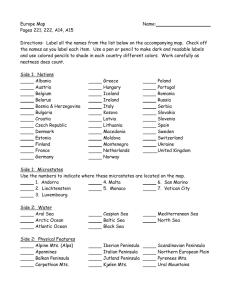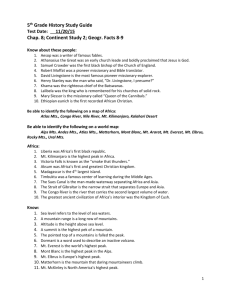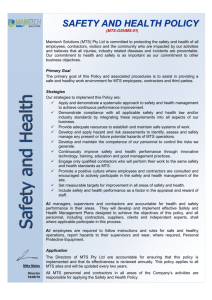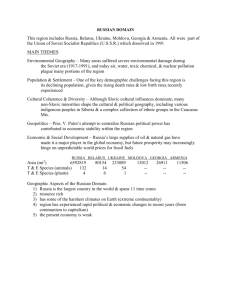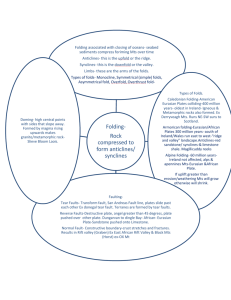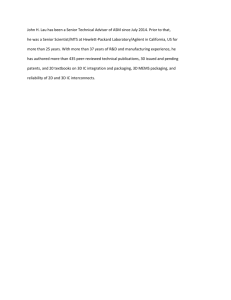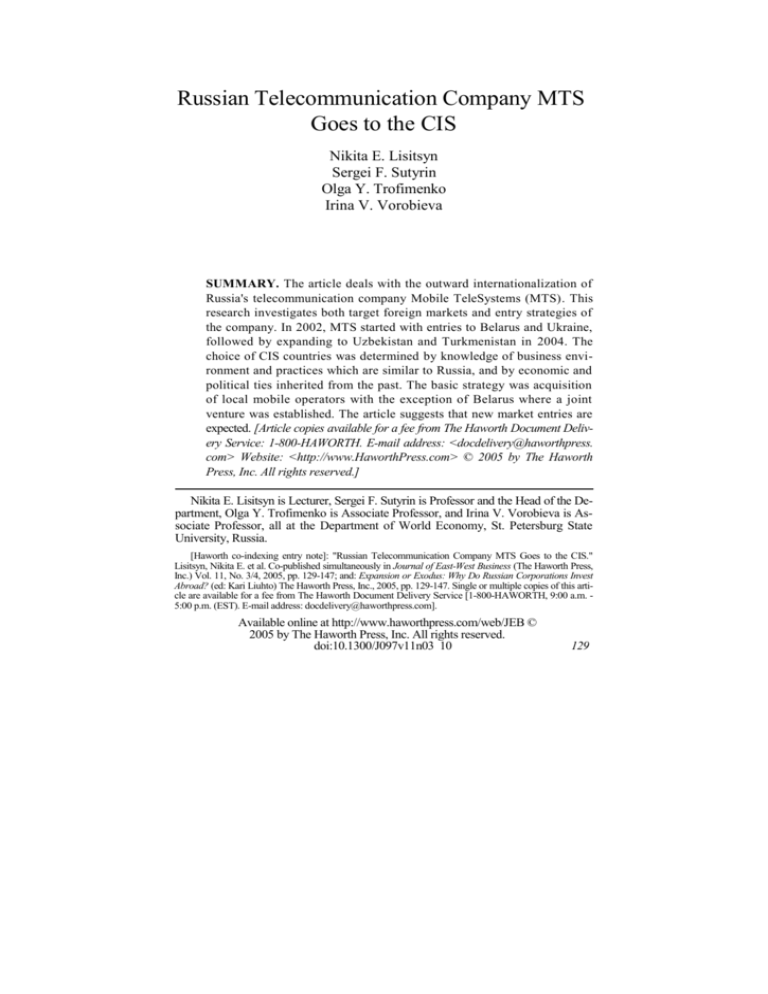
Russian Telecommunication Company MTS
Goes to the CIS
Nikita E. Lisitsyn
Sergei F. Sutyrin
Olga Y. Trofimenko
Irina V. Vorobieva
SUMMARY. The article deals with the outward internationalization of
Russia's telecommunication company Mobile TeleSystems (MTS). This
research investigates both target foreign markets and entry strategies of
the company. In 2002, MTS started with entries to Belarus and Ukraine,
followed by expanding to Uzbekistan and Turkmenistan in 2004. The
choice of CIS countries was determined by knowledge of business environment and practices which are similar to Russia, and by economic and
political ties inherited from the past. The basic strategy was acquisition
of local mobile operators with the exception of Belarus where a joint
venture was established. The article suggests that new market entries are
expected. [Article copies available for a fee from The Haworth Document Delivery Service: 1-800-HAWORTH. E-mail address: <docdelivery@haworthpress.
com> Website: <http://www.HaworthPress.com> © 2005 by The Haworth
Press, Inc. All rights reserved.]
Nikita E. Lisitsyn is Lecturer, Sergei F. Sutyrin is Professor and the Head of the Department, Olga Y. Trofimenko is Associate Professor, and Irina V. Vorobieva is Associate Professor, all at the Department of World Economy, St. Petersburg State
University, Russia.
[Haworth co-indexing entry note]: "Russian Telecommunication Company MTS Goes to the CIS."
Lisitsyn, Nikita E. et al. Co-published simultaneously in Journal of East-West Business (The Haworth Press,
Inc.) Vol. 11, No. 3/4, 2005, pp. 129-147; and: Expansion or Exodus: Why Do Russian Corporations Invest
Abroad? (ed: Kari Liuhto) The Haworth Press, Inc., 2005, pp. 129-147. Single or multiple copies of this article are available for a fee from The Haworth Document Delivery Service [1-800-HAWORTH, 9:00 a.m. 5:00 p.m. (EST). E-mail address: docdelivery@haworthpress.com].
Available online at http://www.haworthpress.com/web/JEB ©
2005 by The Haworth Press, Inc. All rights reserved.
doi:10.1300/J097v11n03 10
129
130
Expansion or Exodus: Why Do Russian Corporations Invest Abroad?
KEYWORDS. Internationalization of a Russian firm, telecommunication, MTS
COMPANY BACKGROUND
MTS is the largest telecom service provider in Russia, operating in
GSM standard. In Russia, the number of its subscribers exceeds 26 million as for the beginning of 2005. Having licenses to provide telecom
services in 87 Russian regions (out of 88) the company currently runs its
operations in 61 regions. In the third quarter of 2004, the revenue of
MTS totaled over one billion US dollars, net profits approached USD
340 million and EBITDA was over USD 630 million. Its market capitalization amounted to USD 13 billion by the end of 2004.
MTS began its operations in October, 1993. The company was
founded by the Moscow fixed-line operator MGTS (Moscow City Telephone Network) and several other domestic shareholders, on the one
side, and DeTeMobil (Deutsche Telecom's subsidiary) and Siemens, on
the other side, as a closed joint stock company. The Russian and the
German shareholders owned 53% and 47% in the company, respectively. In early 1995, AFK Sistema, a Moscow-based financial group,
consolidated the stakes of Russian shareholders; at the same time,
DeTeMobil purchased Siemens' stake. The history of MTS as a public
company began in 2000 with IPO on the US market.
The latest changes in MTS ownership structure took place in the end
of 2004, when Deutsche Telekom sold 15% of Mobile TeleSystems on
the off-board market. At the moment, the controlling stock belongs to
AFK Sistema while the share of Deutsche Telecom (now represented by
T-Mobile company) decreased down to 10%. Nearly one per cent of the
company's shares belong to its management. The rest is traded on
NYSE, European off-board markets and MMVB (Moscow Interbank
Currency Exchange).
MTS is number one among the three largest telecom service providers in Russia. Its market share equals to 35%. Two other leadersVimpelCom and MegaFon-control 34% and 19% of the market correspondingly.
According to the European Mobile Communications (EMC) Report,
the total amount of telecom service subscribers in Russia in all standards has reached 56 million people by the end of the third quarter of
2004 (EMC, 2004). The Russian market provides more than 70% of the
mobile service subscribers in the former Soviet republics. Average pen-
Lisitsyn et al.
131
etration rate in Russia equals to almost 40%. It means that there are still
quite good opportunities for Russian companies to expand inside the
market of the former USSR.
At the same time in Russia the difference between the regions is really large. On the one hand, Moscow with penetration more than 71%
and St. Petersburg with 60% are quite similar to Japan or the USA. On
the other hand, in about twenty regions penetration rate is still below
10%. More than that, one could expect that in the medium run regional
disparity will remain substantial enough. A certain trend towards convergence might occur, resulting from more intensive competition both
in the most developed areas and in other parts of the country.
MTS' GENERAL APPROACH TO NEW MARKET ENTRY
During 1993-2001, MTS was developing on the domestic market, increasing its coverage area by regional expansion within Russia. In
2002-2004 the company started its internationalization by expanding to
neighboring CIS countries. For any company in the mobile communication sector, entering the new national market means the extending of its
network largely through the usage of existing infrastructure in the country of destination. From that point of view, the higher the level of its
technological development the more attractive is the target market. This
factor also strongly favors acquisitions of existing companies, which
operate on the local mobile communications market and have their own
infrastructure and subscriber base. In addition to that, a regulatory factor is rather important for mobile communications sector as the state (in
particular due to security reasons) quite often tries to protect it from foreign operators. In general, a combination of technological and regulatory considerations largely predetermines foreign market entry mode
for the companies in the sector.
MTS started its internationalization in several neighboring CIS countries. The main reasons for choosing these target markets related to historical and cultural traditions, common infrastructure network inherited
from the Soviet era, and relatively similar business practices. In addition to that one should take under consideration geographical proximity,
which clearly favored expansion towards close neighbors. At the same
time, in this case it is a rather controversial issue as several target markets (for example, Uzbekistan) are located relatively far from main Russian economic centers.
132
Expansion or Exodus: Why Do Russian Corporations Invest Abroad?
Integration within the CIS is a priority political target for Russia. Despite all the difficulties, political relations between most of the CIS countries tend to develop positively. Considering the large role of the state in
the mobile communications sector this political ties favor co-operation,
help Russian companies to penetrate regulatory frontiers (that is especially important in cases of Belarus, Uzbekistan and Turkmenistan).
Moreover, internationalization to CIS countries for MTS actually fits
the 'follow your consumer' strategy. Many Russian companies being
MTS corporate clients have already entered markets of CIS countries
and actively develop economic co-operation in the area. Human migration within the CIS is also an important reason, as it formed an initial basis as well as incentive for internationalization by enhancing
co-operation between mobile operators from Russia and other CIS
countries (supplying international roaming services).
Overall mobile service subscriber base in the CIS and the Baltic
States today exceeds 75 million people.1 The region is a fast developing
market where the competition is still rather modest, while the opportunities are substantial. All these countries are transitional economies and
the former USSR republics. They all started the transition process right
after obtaining their sovereignty in 1992. After a dramatic decline in the
1990s, nearly all the economies experienced a rapid growth during the
last five years. Markets of this area, however, do not form an entity, as
they differ tremendously from each other both by subscriber base potential and by current penetration level (see Table 1).
The Baltic States are the leaders in the region under review in terms
of penetration level. In Estonia the penetration reached almost 85%; in
Lithuania it is about 80% and in Latvia 65%. Taking into consideration
the relatively small population of these countries, high level of competition, and the fact that market positions of the already operating telecom
companies are relatively strong, Russian mobile service providers have
not that much incentive to enter these markets today. Another important
factor relates to the recent EU enlargement. After joining the Union, the
Baltic States introduced its rules and regulations on their territory. That
creates additional barriers for the expansion of Russian companies.
Substantial heterogeneity of mobile communication services markets
in the CIS countries mainly results from current variety in standards of
living. For example, Russia has GDP per capita 15 times higher than
Tajikistan (see Table 2). Large and potentially promising markets like
Uzbekistan have low penetration level first and foremost due to the poverty of the majority of the population and absence of middle class.
Lisitsyn et al.
133
TABLE 1. Mobile Subscribers in the CIS
Country
Number of subscribers,
September 2004
Armenia
Change in number of
subscribers (%),
September 2004/
September 2003
Penetration rate (%),
September 2004
150,600
80.1
4.5
Azerbaijan
1,419,400
32.8
18.0
Belarus
1,856,300
115.4
18.0
Georgia
893,700
43.7
18.2
2,203,600
86.5
13.1
Kyrgyzstan
247,200
161.0
5.0
Moldova
654,700
49.1
14.7
Kazakhstan
Russia
56,106,140
88.6
39.0
Tajikistan
95,180
637.3
1.4
Turkmenistan
13,650
35.0
0.3
10,299,100
116.7
21.6
467,100
91.5
1.8
Ukraine
Uzbekistan
Source: Calculated from EMC (2003; 2004).
TABLE 2. Basic Macroeconomic Indicators of CIS Countries
Russia
Territory,
thousand
square km
Population,
million
GDP per
capita,
2003,
USD
GDP growth (%)
1998
1999
2000
2001
2002
2003
17,075.2
143.4
3,023.0
-5.3
6.4
10.0
5.1
4.7
7.3
Ukraine
603.7
48.4
1,022.7
-1.9
-0.2
5.9
9.2
4.8
8.5
Uzbekistan
447.4
25.6
386.7
4.4
4.4
3.8
4.5
4.2
4.4
2,717.3
14.9
1,993.3
-1.9
2.7
9.8
13.5
9.8
9.2
207.6
9.9
1,767.7
8.3
3.4
5.8
4.7
5.0
6.8
Kazakhstan
Belarus
Azerbaijan
86.6
8.2
865.9
10.0
7.4
11.1
9.9
10.6
11.2
Tajikistan
143.1
6.3
206.4
5.3
3.7
8.3
10.2
9.5
10.2
Kyrgyzstan
198.5
5.1
333.3
2.1
3.7
5.4
5.3
0.0
6.7
69.7
5.1
764.7
3.1
2.9
1.8
4.8
5.5
488.1
4.9
1,224.5
Georgia
Turkmenistan
8.6
16.9
Moldova
33.8
4.2
476.2
-6.5
-3.4
2.1
6.1
7.8
6.3
Armenia
29.8
3.1
903.2
7.2
3.3
5.9
9.6
12.9
13.9
Sources: Intergovernmental Statistical Committee of the CIS Countries (2005); World Bank (2005).
134
Expansion or Exodus: Why Do Russian Corporations Invest Abroad?
Several large companies dominate the telecom market of the CIS and
the Baltic States. Relevant information is depicted in Table 3. The table
shows that MTS being the leader on the Russian market at the same time
manages to enter more foreign countries than any of its main competitors.
Belarus
Belarus happened to be the first CIS target destination for MTS. With
its population of nearly 10 million, Belarus is the fifth largest country of
the alliance. The population density is some 50 people per sq. km. GDP
growth varied from 3% in 1999 to 7% in 2003. In 2003, GDP per capita
amounted to close USD 1,800 (the third place among the CIS countries).
Belarus has lagged behind most East European transition countries in
developing mobile communications. It was the last state in the region to
introduce GSM cellular digital standard, having relied between 1993
and 1999 on an analogue cellular phone service. Mobile phone penetration has nevertheless increased rapidly in recent years. In particular, it
more than doubled from September 2003 to September 2004, and has
reached the level of about 20% with approximately two million mobile
subscribers. Meanwhile, the potential of the Belarus cellular market has
TABLE 3. Ten Leading Mobile Services Providers in the CIS and the Baltic
States
Company
Country of origin
Countries of operation
MTS
Russia
Russia, Belarus, Ukraine, Uzbekistan, Turkmenistan
VimpelCom
Russia
Russia, Kazakhstan
MegaFon
Russia
Russia, Tajikistan
Fintur
Netherlands
Kazakhstan, Azerbaijan, Georgia, Moldova
TELE2
Sweden
Russia, Latvia, Lithuania, Estonia
Kyivstar
Ukraine
Ukraine
Uralsvjasiform
Russia
Russia
SMARTS
Russia
Russia
Omnitel
USA
Lithuania
MDC(VELCOM)
Belarus
Belarus
Source: Calculated from Averin (2004).
Lisitsyn et al.
135
not been exhausted yet. Two companies dominate the Belarus mobile
service market: MTS Belarus and Mobile Digital Communication (MDC).
The third company, BelCel, keeps rather modest market share.
MDC operates under the VELCOM brand name. The company was
set up in July 1998 as a joint venture between Belarus' state-controlled
fixed-line monopolist Beltelecom (share of 31%), an armament and
military equipment exporter Beltekhexport (share of 20%), and Cypriot
SB Telecom Ltd (share of 49%).
MDC has base stations in all localities with population exceeding
10,000 residents. Its network covers 45% of national territory. During
2004, the company lost the leading market position it had enjoyed for
more than five years. MDC market share decreased down to 45% in
September 2004 from 56% in the beginning of the same year. Mean
while, the company announced the plans to regain its leading position in
2005. To achieve this goal it is going to invest at least USD 65 million in
new base stations aiming to cover 100% of urban population and 65%
of the total Belarus territory.
BelCel was established in May 1993 as a Belarus-British joint venture. Currently, the company belongs to the Netherlands' CIB BV
(50%), state telecom operator Minskaya Gorodskaya Telefonnaya Syet
(30%), state company Minskobltelecom (3%), and Infobank (17%).
A new company, Belarus Telecommunication Network (BEST), was
set up in November 2004 as a closed stock company jointly owned by
state fixed-line monopolist Beltelecom and Agat, the state-run enterprise that manufactures, among other products, air defence computer
control systems. BEST services have already launched in 2005.
MTS decided to enter the Belarus market via the establishing of a
joint venture with a local company. It was long-distance operator
Mezhdugorodnaya Svyaz. MTS Belarus began its operations in June
2002. Currently, MTS and Mezhdugorodnaya Svyaz hold respective
stakes of 49% and 51% in the joint venture.
In 2004, MTS Belarus outran MDC and became the leader on national mobile market in terms of number of subscribers and the territory
coverage. Access to company network is available on half of Belarus
territory with 93% of urban population. These results were positively
assessed by the Russian mother-company, which claimed that the more
than two-year-long history of operations in Belarus appeared to be mutual beneficial for both partners.
Future prospects for MTS Belarus to a large extent depend upon the
ability of the company to compete successfully both with MDC and
BEST. The latter has really ambitious expansion plans to cover 60-70%
136
Expansion or Exodus: Why Do Russian Corporations Invest Abroad?
of the Belarus territory, including areas in which other existing companies have failed so far to establish their presence. While providing access to mobile services for low-income groups and rural residents these
activities correspond to Belarus social regional development policy.
Under the circumstances the company might rely on various forms of
governmental support, in particular on state guarantees in obtaining
loans.
Generally speaking, the political factor in a broad sense of the word
is a very significant one for doing business in Belarus. This is particularly true for the telecommunication sector. In particular, the Belarus
Government constantly reveals its serious concern regarding capital
flight. Accordingly, both MTS and MDC were accused of withdrawing USD 20 million annually from Belarus. These accusations are
largely groundless. In addition to their substantial contribution to wireless communication development in Belarus, MTS and MDC annually
pay about USD 80 million in taxes (Sharova, 2004).
The attitude of the government is also crucial with respect to the
plans of MTS to increase its stake in MTS Belarus up to 51% and afterwards seriously increase its investments. Previously the state had preferred to keep a larger interest in telecom companies. At the moment
CIB BV with its 50% is the only exception. So far investments of the
Russian partner into MTS Belarus have amounted to over USD 130 million since 2002. In the nearest future, MTS Belarus aims at improving
the quality of services by investing substantially in the network development. In 2005, MTS Belarus plans to extend the installed capacity up
to three million numbers. To achieve the goal the company is going to
purchase state-of-art equipment and launch additional base stations in
all regional centers.
Ukraine
Ukraine was the second target destination for MTS after Belarus.
MTS entered this market just a few months later. In terms of population,
Ukraine is the second largest market in the CIS (close to 50 million people). The population density is also relatively high-80 people per sq.
km. After eight years of decline since the Soviet Union collapsed,
Ukraine has been experiencing economic growth since 2000. GDP
growth rate in Ukraine was even higher than in Russia and varied from
6% in 2000 to over 8% in 2003. At the same time, GDP per capita remains quite low (slightly over USD 1,000). This is far behind Russia
and Belarus.
Lisitsyn et al.
137
The Ukrainian mobile service sector is one of the dramatically growing industries in the country. The number of subscribers has been increasing rapidly (by 140% in 2001, 60% in 2002, and 80% in 2003). In
September 2004, there were about 10 million mobile subscribers. According to mobile operators' forecasts, this figure could be more than 20
million by the end of 2005. The growth of the sector could be explained
by two main reasons: low penetration rate of fixed lines (24%) and substantial price fall for mobile services. However, the penetration rate in
the Ukrainian mobile sector is still quite low; it is just crossed 22%.
There are currently five licensed mobile operators in Ukraine. At the
same time, the market in Ukraine is very similar to a duopoly model.
The market is divided by two main players-Ukrainian Mobile Communications (UMC) and KyivStar GSM-which control together about
98% of the mobile sector. The remaining three mobile operators, Golden
Telecom (GT), Ukrainian Radio Systems (URS, traded as WellCOM)
and Digital Cellular Communications (DCC), do not significantly influence the market.
KyivStar GSM was founded in 1994 as a joint stock company. The
company began its operations in 1997. It belongs to Norway's Telenor
Mobile Communications (54%), the Ukrainian company Storm, and the
local investor Omega (6%). The network of KyivStar covers the largest
part of the Ukrainian territory and 87% of the country's population. The
company plans substantial investments in order to improve quality of
services.
MTS entered the Ukrainian mobile market in 2002 via purchasing the
controlling interest of UMC (58% of shares). Step by step, the Russian
company bought shares from the other owners. At the moment, MTS
holds 99% of the Ukraine company directly and one per cent through its
subsidiary PPT Telecom Kyiv. UMC was established in 1992 as a joint
venture between national fixed-line operator Ukrtelecom (51%), TDC
AS (Denmark), Deutsche Telekom (Germany), and Royal KPN NV
(the Netherlands); each foreign company got 16% (Paul Budde Communication, 2002).
For the first eight years of operations UMC was the market leader.
The trend changed in mid-2001, when the company faced network capacity problems and stopped accepting new subscribers for three months.
KyivStar managed to use the opportunity to become a leader. At the end
of 2001, the market share of UMC fell down from 55% to 46% (EMC,
2003).
When MTS decided to enter the Ukrainian mobile market, UMC was
the second player. A brief history of the purchasing of UMC by the Rus-
138
Expansion or Exodus: Why Do Russian Corporations Invest Abroad?
sian company included several stages. In November 2002, MTS applied
to the Ukrainian antimonopoly committee for permission to buy 58% of
UMC and simultaneously to sign an option agreement to purchase the
remaining 42% for some USD 140 million in 2003-2005. The first decision to sell UMC was taken by the Viktor Yushchenko government. In
November 2002, MTS signed a USD 194 million contract to buy the
first share holding by the end of the year. This controlling stake in its
turn consisted of three parts. Ukrtelekom sold 25% of state ownership
for approximately USD 85 million. Two packages of shares of Deutsche Telekom and KPN were sold for USD 55 million each. Since
March 2003, MTS began to consolidate UMC in its financial statements.
Then MTS signed an option contract with Ukrtelekom to acquire a
26% share of UMC for almost USD 90 million. MTS took up the option
in June 2003. MTS also signed an option contract to buy from TDC a
16% share of UMC for a price not less than USD 55 million. This share
holding was actually sold in July 2003 for some USD 90 million. Being
the only owner of UMC, MTS in April 2004 decided to transform the
mobile operator from a limited liability enterprise into a closed joint
stock company.
One could argue that the influence of MTS as an owner was rather
positive for UMC. Managerial, financial and other types of input helped
the latter to restore the leading position on the Ukrainian mobile market.
Thus, the number of UMC subscribers as a subsidiary of MTS doubled
in two years and the growth rate was higher then one of Kyivstar for the
same period.
MTS also invests intensively in the network development. While
UMC's total investments in ten years period amounted to over USD 450
million, MTS spent over USD 250 million on the UMC development in
2003 alone. According to estimates, the total stock of MTS investments
in Ukraine amounts to USD 1.2 billion by the end of 2004. MTS actively
co-operates with leading equipment suppliers (Alcatel and Siemens) to
expand the UMC GSM network, optimize existing infrastructure, and accelerate development of next-generation products and services. As of
September 2004, UMC's network covered over 80% of the country's territory and about 90% of the population. Having the status of the MTS
subsidiary, UMC gets better access to foreign financial sources. Thus in
2004, UMC took over a USD 50 million loan from ING BHF-Bank and
Commerzbank for financing the purchase of GSM equipment from
Siemens.
Lisitsyn et al.
139
However, despite certain success MTS faced some serious problems
in Ukraine. They basically come from a high level of political risk in the
country and ideas of re-privatization. In the case of UMC, the Ukrainian
Prosecutor-General's Office (the PGO) in June 2004 claimed that the
sale of Ukrtelecom share of the company to MTS was in breach of
Ukraine's privatization laws, and therefore announced a re-privatization campaign. The initiators of the idea would like Ukrtelekom to regain 51% of UMC. In exchange, Ukraine would pay back to MTS the
entire sum of money that it spent for the deal (over USD 170 million).
At the same time, the Ukrainian Government does not examine any options that would allow MTS to get back its investments on the UMC development (BBC, 2004).
MTS managed to prove that it did not break the law and to win the trial
in the court. The company also claimed that it was a victim of internal political disputes connected with the presidential election (EIU, 2004). Nevertheless, the Ukrainian Prosecutor-General said he would take another
attempt to give the company back to Ukrtelecom. In addition to that, the
case could be put on the agenda in connection with future plans to privatize Ukrtelecom. Since it sold its share to MTS, Ukrtelecom's value
dropped down. The Ukrainian authorities wanted to increase as much as
possible an attractiveness of future privatization tender. Due to the presidential election, these plans were postponed and it is not clear yet when
the new government will come back to the issue.
Ukrainian authorities also blame UMC for low level of quality services. According to them, the mobile operator while attracting more clients does not care much about sufficient technical support. In particular,
the company's subscribers suffered serious communication problems in
Kyiv over August 31 st-September 1st 2004. This infringes on the interests of consumers and maybe considered as violation of the competition
law. The Antimonopoly Committee forced the company to take urgent
measures, threatening to take away its license. UMC announced it
would compensate subscribers' losses. In addition to that it was actually
forced to install five new switchboards to increase installed capacity
and to avoid network congestion (Voltornist & Afanasiev, 2004).
The Antimonopoly Committee also criticizes UMC for keeping prices
too high (at USD 0.13-0.21 per minute). In turn, MTS argues that the arrival of MTS on the Ukrainian market "was a powerful jolt for its development: the level of penetration of cellular communications doubled.
We are investing in the development of the country's telecommunications market and its infrastructure, which is beneficial both for the state
and for consumers" (BBC, 2004).
140
Expansion or Exodus: Why Do Russian Corporations Invest Abroad?
Despite the problems, MTS would like to stay at the Ukrainian market. It is going to pay extra attention to network development, to open
new service centers (own and joint offices with the dealers), and to plan
intensive marketing campaigns.
Uzbekistan
Uzbekistan is the third largest country in the CIS after Russia and
Ukraine in terms of population. Almost 26 million inhabitants live
there. The population density equals to over 50 persons per sq km. Similar to other CIS member-countries, Uzbekistan is a relatively fast developing market with GDP annual growth rate of about four per cent
during the last seven years. At the same time, national living standards
still remain pretty low with GDP per capita less than USD 400 in 2003.
Fixed telephone lines in Uzbekistan are obsolete, inadequate, and in
serious need of modernization. The number of subscribers does not exceed two million people (less than 8% of population). As for mobile
communication, the penetration rate currently does not exceed two per
cent. At the same time, the Uzbek mobile market has started to grow really fast. For example, the number of mobile phone users in the country
reached almost 470,000 in September of 2004 in comparison with
325,000 at the end of 2003. Under the circumstances economic agents
assess prospects for the Uzbek mobile communications market as really
promising, especially in the medium and long run.
Six companies currently run their operations on the Uzbek mobile
communications market. Two of them keep dominant positions, namely
Uzdunrobita with 250,000 subscribers and Daewoo Unitel with over
100,000 subscribers. The others are far behind the leaders.
Daewoo Unitel, launched in 1997, is the second largest GSM network operator in Uzbekistan with a market share of 23%. Its network
covers major densely populated areas of the country. In autumn of 2004,
Daewoo International sold the company for USD 75 million to a consortium of Germanos SA (the largest telecom equipment company in
Greece), EBRD, and Global Finance (Greek private equity and venture
capital firm that manages the Black Sea Fund, in which the EBRD is an
investor). Germanos SA decided to participate in this acquisition taking
under consideration favorable prospects for the market under review as
well as a commitment to vertical integration strategy. On the other hand,
having EBRD as one of the shareholders, Daewoo Unitel might have a
better access to financial resources. This would allow the company to
develop and modernize its network. The activities under review should
Lisitsyn et al.
141
be mostly focused on expanding the geographic coverage and product
range. The ultimate goal is to make mobile services more affordable in
economic terms and hence to capture the lower income segment of the
population.
MTS began its expansion towards Uzbekistan through the acquisition of Uzdunrobita, the leading mobile service company functioning in
the country, which controlled approximately a half of the market. The
deal immediately put MTC into the position of a leading player in the
market. In August 2004, MTS purchased three-quarters of Uzdunrobita
for some USD 120 million from two private companies. The agreement
also included an option to acquire the remaining quarter for not less than
USD 40 million. In this case MTS will be the only owner of the company. The deal requires the permission of national regulators both in
Russia and Uzbekistan, as well as approval of the MTS board of directors, before it can be completed. MTS plans to participate in further development of Uzdunrobita projects aimed at improving the quality of its
services.
The acquisition of Uzdunrobita was an expensive one for MTS. Indeed, the company already paid almost USD 500 per each subscriber it
got. At the moment it looks like an open question whether MTS will
manage to recoup its investments quickly enough and to gain sufficient
experience for future market expansion towards other countries.
Turkmenistan
Turkmenistan became only recently the target country of MTS foreign
market extension. The population of Turkmenistan is not as large as in
other CIS countries where MTS operates (5 million people). The population density is relatively low (10 people per sq. km). The Turkmen
economy has been demonstrating the highest GDP growth in the CIS region in the last several years (some 17% in 1999, 20% in 2002, 17% in
2003). In terms of GDP per capita, the country has the fourth highest
rating in the CIS (over USD 1200 in 2003). The penetration of mobile
communication services does not exceed one per cent-the lowest level
in the CIS region. Analysts regarded Turkmenistan as a great potential
market for telecommunications.
By the beginning of 2005, the USA-based American Barash Communication Technologies Inc. (BCTI) was the only mobile communication
company in Turkmenistan. BCTI owns the entire range of frequencies required to establish GSM and 3G networks: 900 MHz, 1,800 Mhz, 1,900
142
Expansion or Exodus: Why Do Russian Corporations Invest Abroad?
MHz and others. The only other mobile communication license belongs
to the Turkmen Ministry of Telecommunications.
Similar to its previous experience in Uzbekistan, MTS decided to enter the Turkmen market by purchasing the leader. At the moment, the
deal valued for USD 55 million is at the final stage, although MTS has
not confirmed it yet. If the purchase takes place, it would be the highest
per-subscriber price ever paid by a Russian mobile company for cellular
assets. Despite direct commercial considerations, experts treat the contract as a very important one from the political point of view. For the
first time in the post-Soviet history, a Russian telecom company could
get the position of the monopolist on the foreign market.
Kazakhstan
The mobile penetration level in Kazakhstan slightly exceeds 13%; that
is much less than in Russia. To date, the market is still in its infancy. That
mainly results from the vast territory of the country in combination with
inadequate infrastructure. At the same time, that provides good growth
opportunities. The number of mobile subscribers increased more than
13-fold since 2000. Annual growth in 2004 slowed down in comparison
with previous years, but 86% still looked impressive and attractive for
newcomers.
Competition on the national market is high compared to that in
Uzbekistan and Turkmenistan. The general situation resembles the
Ukrainian model. There are two obvious leaders (GSM-Kazakhstan and
KaR-Tel) as well as two smaller companies.
GSM-Kazakhstan (works with two trademarks, K-cell and Active)
today holds almost three-quarters of the Kazakh telecom market. The
total number of its subscribers amounts to over one million as of August
2004. The company has two main owners: 51% of its stock belongs to
the Dutch company Fintur Holdings B.V. (owned by Scandinavian
TeliaSonera and Turkish Turkcell) and 49% are the property of nationally-based Kazakhtelecom.
Kazakhstan's second largest mobile operator, KaR-Tel (works with
two trademarks K-Mobile and Excess), has approximately 600,000 registered subscribers at the end of August 2004, and its market share is
about 25%. Initially, KaR-Tel was a Kazakh-Turkish joint venture but
the Kazakh side accused its two Turkish partners in non-observance of
obligations and took their shares back through the court. In August
2004, Kazakh owners organized a tender for KaR-Tel. Eight companies participated in the tender; among them were the Russian mobile
Lisitsyn et al.
143
operators MTS and VimpelCom. The latter won the tender and purchased whole KaR-Tel from the Kazakh parent company for USD 350
million and simultaneously took a burden of KaR-Tel's huge debt
(Yevstigneyeva, 2004).
The price of the deal was pretty high, but VimpelCom perceives the
Kazakh mobile market as very important for its international expansion, as it was the first foreign market for the company. VimpelCom
had previously focused on the rapid growth of its network towards the
Russian regions. Moreover, buying a local operator may be the only
path to international expansion in Kazakhstan. Earlier in February
2004, VimpelCom tried and failed to win a tender for Kazakhstan's
third GSM license. The aim of the company in Kazakhstan for the coming years is reportedly to increase mobile penetration in urban areas to
70% (more than half of the Kazakh population lives in urban areas).
So far Kazakhstan is the only CIS market where MTS has tried and
failed to enter. On the other hand, relatively low penetration level and
importance of Kazakhstan as a large and rapidly developing market is a
challenge for the leader of Russian telecom. Deepening of economic integration between Russia and Kazakhstan may enhance the penetration
of the Russian companies to the neighboring country, and many of them
are corporate clients of MTS. That may create an additional incentive
for the company to repeat its attempts to enter the Kazakh market.
Other CIS Countries
Armenia, Azerbaijan, Georgia, Kyrgyzstan, Moldova and Tajikistan
have much in common and generally belong to MTS' target markets in
the CIS. Under the circumstances one might argue that the company
sooner or later will try to enter them within the framework of its further
internationalization efforts.
All the aforementioned countries are relatively small in terms of population (the smallest one-Armenia-has only three million inhabitants)
and have low living standards (Tajikistan has the lowest income level in
the CIS as well as one of the lowest in the world). Nevertheless, development of the telecom sector in these countries varies. For example,
Tajikistan, Kyrgyzstan and Armenia are evident outsiders among the
CIS countries in terms of such indicators as subscriber base and penetration level, which do not exceed five per cent.
Azerbaijan might be perceived as a relatively promising target. However, its market is mostly closed and highly monopolized. Just two mo-
144
Expansion or Exodus: Why Do Russian Corporations Invest Abroad?
bile operators control the market. Azercell Telecom is a joint venture
holding almost 70% of the national market of mobile communications
in Azerbaijan. The company, founded in 1996, belongs to the state
(51%) and to a foreign investor, Fintur Holding B.V. (49%). Bakcell
was the first privatized mobile operator in Azerbaijan, which initially
had been partly state owned, but later became fully private. Today this
operator belongs to an Israel company, GTIB-96. Bakcell holds 30% of
the Azerbaijan telecom market.
State officials express doubt about the intentions of Russian companies (first of all MTS and Rostelecom) to enter the market. They argue
that the Azerbaijan telecom market currently does not need a third operator due to drawbacks in the licensing system. Moreover, if such an opportunity arises, the state could look at more appealing bids than MTS
for the third operator. At any rate, MTS has not still made any official
offer to the Azerbaijan telecom regulating authorities.
Georgia and Moldova are both markets with rather high competition
(penetration level equals to 18% and 15% correspondingly) and the
presence of national and foreign telecom companies (from the USA, the
EU, and Turkey). But experts assess these markets as having relatively
low growth potential. Territorial conflicts still split the territories of
these states. For example, Moldova still has two separate communication networks: one for the Dniester Moldovan Republic, and one for the
rest of the country. The same problems exist in Georgia.
The Armenian market was monopolized for a long period, and the
only operator was ArmenTel. This monopoly had a negative impact on
the overall development of mobile communication in the country. In
particular, penetration level equals to some five per cent only. In November 2004, the Armenian Government deprived ArmenTel of the exclusive right for GSM and satellite communication services. In the same
month a second mobile operator, nationally-based K-Telekom, appeared on the market. This recent reform gave a green light to foreign
companies (Russian as well) interested in entering the Armenian market.
Kyrgyzstan has one of the lowest income levels within the CIS (GDP
per capita in 2003 was less than USD 350). Nevertheless, low penetration rate (5%) presumes high growth potential. There are two mobile
operators on the market, but there is still enough space for the newcomers, and the current subscriber base growth is very high. So, the Kyrgyz
market of mobile communication is rather interesting for the Russian
companies. Experts suppose that VimpelCom and MegaFon may take
Lisitsyn et al.
145
certain efforts to enter this market in the nearest future, and that is an obvious challenge for MTS.
Tajikistan, the poorest among the CIS countries, experienced the
highest market growth rates in the alliance (almost 640 from September 2003 till September 2004). That fact already attracted one leading
Russian operator, MegaFon, which entered the Tajik market in 2001 by
acquiring 75% of local operator TT Mobile. Besides, there are three
other telecom companies on the market. Taking into account that for
MegaFon Tajikistan is the only foreign market, one can argue that MTS
may not concentrate on expanding to this country, at least in the short
run.
CONCLUSIONS
In each CIS country where MTS operates one could observe sustainable mobile market growth. This growth could be explained by two
main reasons: an urgent need for modern communication tools on the
one hand, and aggressive marketing campaigns of mobile service providers on the other hand.
Entry modes for MTS were predetermined by technological and regulatory considerations. As for target markets, they largely resulted from
historical and cultural traditions, common infrastructure network, similar business practices, and development of re-integration process within
the framework of the CIS. MTS started the internationalization process
in 2002 and since then entered several markets in the region gradually
increasing its experience. One could argue that MTS would use its
knowledge and existing positions as the platform for future expansion
to other CIS countries.
Due to various types of similarities between Russia and its neighbors
MTS may better understand market environment in the region in comparison with Western counterparts, and therefore use this understanding
as its competitive advantage. At the same time, the main threats would
most probably come not from national telecom service suppliers, but
from large Western telecoms with huge financial recourses.
Regarding regulatory issues, it is necessary to mention that without
the political will of the national authorities MTS could not get access
to their privatization processes. In addition to that, due to the high
level of monopolization in most of the countries under review, in order
to be successful MTS should establish a good relationship with local
anti-monopoly agencies.
146
Expansion or Exodus: Why Do Russian Corporations Invest Abroad?
MTS positions itself as an international company and the leading mobile service provider in Russia and the CIS countries. Hence, in three
cases (out of four) it entered foreign countries by purchasing the most
successful national mobile companies with prominent market shares.
Only in Belarus it made greenfield investments and then the company
did its best to gain the leading position in the local telecom sector.
NOTE
1. Estimations for the end of 2004.
REFERENCES
Averin Sergei & Fomina Ekaterina (2005). Obzor rinka sotovoi svjazi Ukraini. Itogi
2004. Sotovik. http://www.sotovik.ru/analyt/sng/ukrain/ukrain_226.html.
Averin Sergei &Fomina Ekaterina (2005). Obzor rinka sotovoi svjazi stran SNG i
Baltii. Itogi 2004. Sotovik. http://www.sotovik.ru/analyt/russia/russia2004/index_
230.html.
Averin Sergei (2004). Obzor rinka sotovoi svjazi stran SNG i Baltii. Itogi 3Q2004.
Sotovik. http://www.sotovik.ru/analyt/russia/russia2004/index_212.htm.
BBC Monitoring (2004) Web site looks at moves to cancel sale of Ukrainian mobile
phone company. BBC, June 23, 2004. http://www.monitor.bbc.co.uk.
CIT (2003). Datafile of Eastern European Telecommunications. CIT Publications
Limited, September, 2003, p. Ukr_1-Ukr_ F4.
Efimova Elena, Vadim Kapustkin & Sergei Sutyrin (1996). Comparative analysis of
foreign entry strategies of western and CIS firms in each other markets. Choice and
Management of Entry Strategies in International Business. Proceedings of the University ofVaasa, Jorma Larimo and Tuija Mainela (eds.). Vaasa.
EIU (2004). Ukraine will seek to annul 2002 deal with MTS. The Economist Intelligence Unit Research report, June 24, 2004. http://www.eiu.com.
EMC (2003). European Mobile Communications Report. Issue 176, 2003. http://www.
emc-database.com.
EMC (2004). European Mobile Communications Report. Issue 186, 2004. http://www.
emc-database.com.
Gaidar Egor (2005). Postsovietskaya Istoria. Vedomosti. Issue No. 8 (1289). Moscow.
Intergovernmental Statistical Committee of the CIS Countries (2004). Economic Development of the CIS Countries. Report. http://www.cisstat.com.
Johansson, Jan. & Vahlne, J.-E. (1990). The Mechanism of Internationalization. International Marketing Review, 7 (4): 11-24.
J'son & Partners (2004). Cellular Communication in Russia Information Bulletin.
J'son & Partners Management Consultancy. http://www.json.ru.
Liuhto Kari (ed.). (2001) East Goes West-The Internationalization of Eastern Enterprises (2001). Lappeenranta University of Technology, Lappeenranta.
Lisitsyn et al.
147
McMillan Carl H. (1996). Foreign Investment in Russia: Soviet Legacies and Post-Soviet Prospects. Foreign Investment in Russia and Other Soviet Successor States. Ed.
by Artisien-Maksimenko P., Adjubei Y. London, 1996.
Paul Budde Communication (2002) Telecoms in Russia, Belarus, Moldova and Ukraine
2003. Paul Budde Communication, pp. 1-54 http://www.budde.com.au/publications/
annual/eastern europe/russia-belarus-moldova-ukraine.html.
Paul Budde Communication (2004). South Asian Telecoms, Mobile and Broadband
Market reports. http://www.budde.com.au/publications/annual/asia/south-asianmarket-su mmary. html.
Sharova Yuliya (2004). State-Run Third GSM Operator to be Established for Taxpayers' Money, BelaPAN Economic Review, 25.10.04. http://www.belapan.com.
Vahtra Peeter, Liuhto Kari (2004). Expansion or Exodus?-Foreign Operations of the
Russia's Largest Corporations. Pan-European Institute Electronic Publications.
8/2004. http://www.tukkk.fi.
Voltornist Andriy & Afanasiev Andrew (2004). Ukraine Mobile: Subscribers Prefer to
Prepay, IntelliNews Publication, September 20, 2004, ISI Emerging Markets,
http:// www.securities.com.
Welch Lawrence & Luostarinen Reijo (1993). Inward-Outward Connections in Internationalisation. Journal of International Marketing. Vol. 1, Issue 1. pp. 44-56.
World Bank (2005). World Development Report. World Bank Group, http://
worldbank.org.
WTO (2005). World Trade Report, World Trade Organisation, http://www.wto.org
Yevstigneyeva Tatyana (2004). Russian Mobile Expansion to Strengthen Kazakh Market, IntelliNews Publication, September 6, 2004, ISI Emerging Markets. http://
www.securities.com.
Numerous articles in various business reviews and Internet sources, information obtained from the companies under review.

